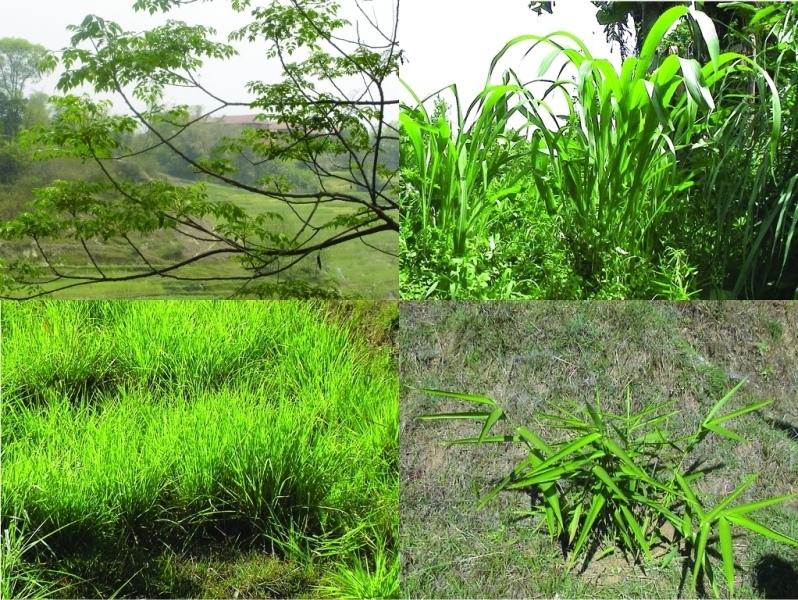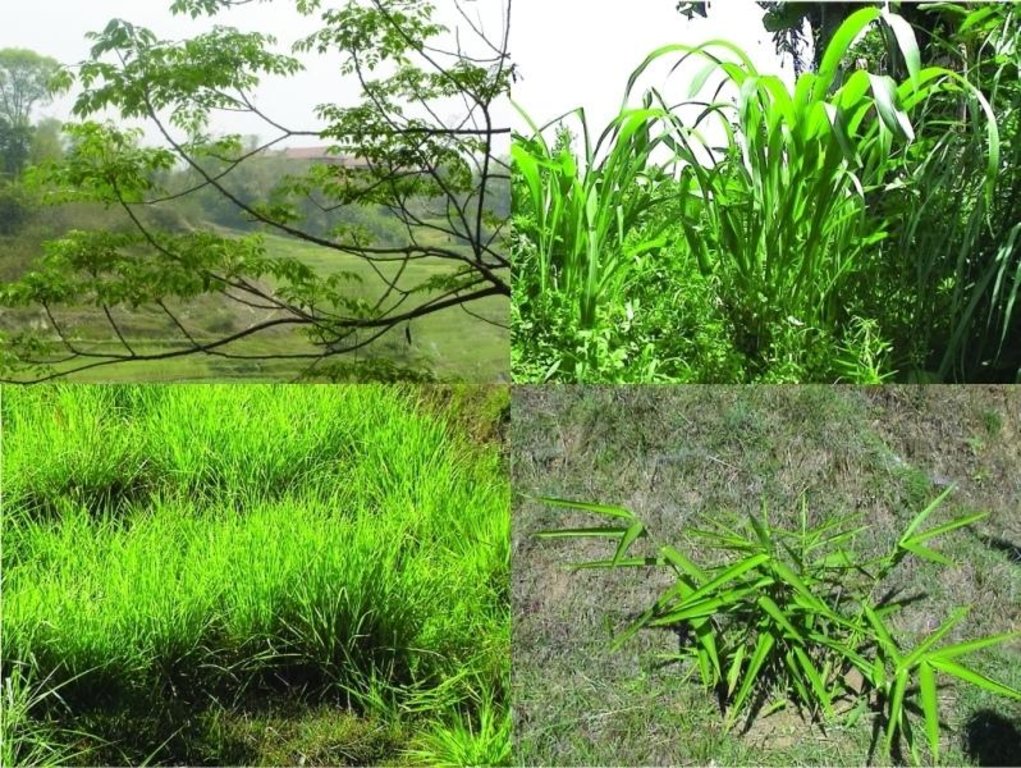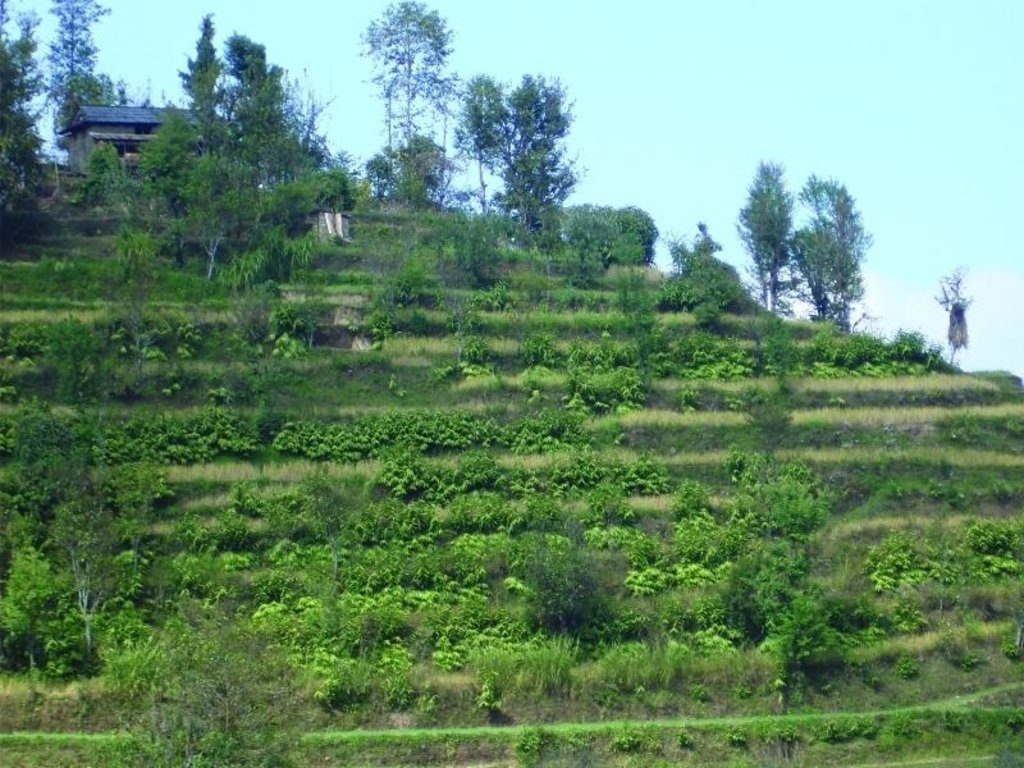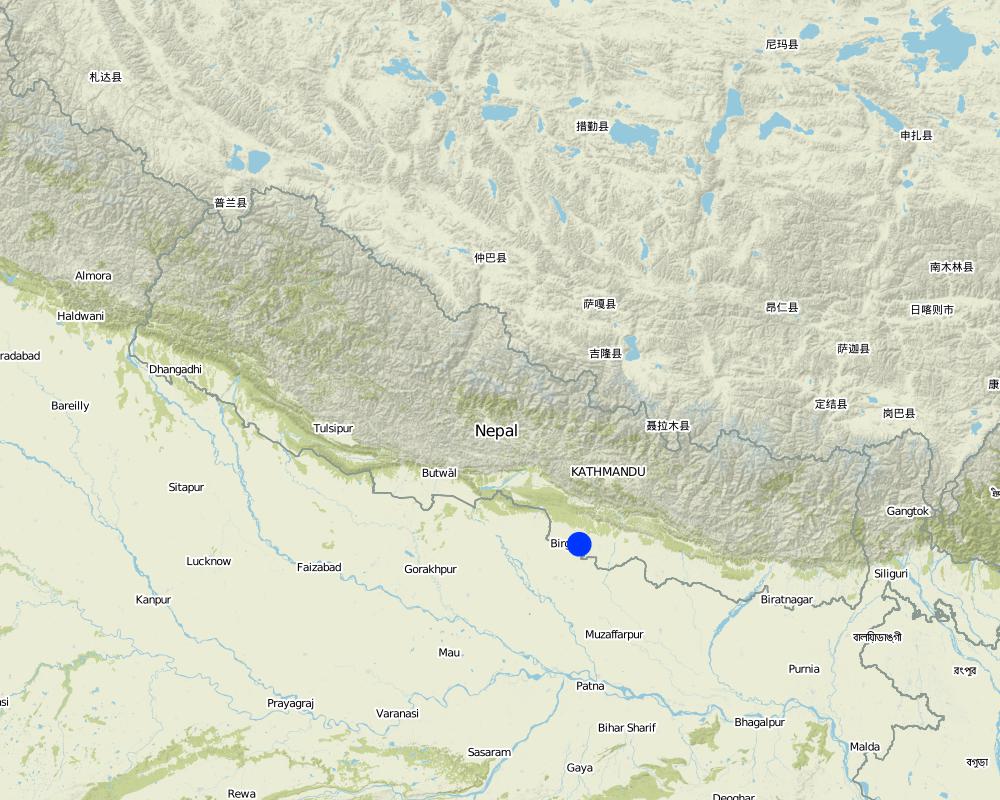Cultivation of fodder and grasses [Nepal]
- Creation:
- Update:
- Compiler: Richard Allen
- Editor: –
- Reviewers: David Streiff, Alexandra Gavilano
Dale ghans tatha bhuin ghans prawardhan
technologies_1757 - Nepal
View sections
Expand all Collapse all1. General information
1.2 Contact details of resource persons and institutions involved in the assessment and documentation of the Technology
Key resource person(s)
SLM specialist:
SLM specialist:
Director
Soil Management Directorate, Department of Agriculture
Nepal
SLM specialist:
Team Leader
Sustainable Soil Management Programme
Nepal
1.3 Conditions regarding the use of data documented through WOCAT
The compiler and key resource person(s) accept the conditions regarding the use of data documented through WOCAT:
Yes
1.5 Reference to Questionnaire(s) on SLM Approaches (documented using WOCAT)

Farmer field schools on integrated plant nutrient systems [Nepal]
Participatory and collaborative learning through the farmer field school approach
- Compiler: Richard Allen

Farmer-to-farmer diffusion [Nepal]
Wider diffusion of sustainable soil management technologies through a demand responsive farmer-to-farmer diffusion approach
- Compiler: Richard Allen
2. Description of the SLM Technology
2.1 Short description of the Technology
Definition of the Technology:
Cultivation of fodder crops on marginal lands and terrace risers
2.2 Detailed description of the Technology
Description:
Fodder plays a major role in the crop-livestock-manure-soil nutrient cycle on farms in the middle mountains of the Himalayas. Livestock convert fodder shrubs and grasses from the forest, crop residues, and other fodder into manure through digestion. However, in the middle hills of Nepal the lack of availability of good quality fodder often limits not only, the productivity of livestock, but also reduces the nitrogen content of animal dung if, for example, only cereal crop residues, are fed to the animals.
In earlier times, livestock were left to graze in the forests and on community lands. The animals sought out their own food and were only assembled for milking and to protect them from wild animals. With the introduction of stall-feeding, the demand for fodder has increased greatly with a subsequent large increase in women’s workload as it is they who are responsible for collecting the fodder.
Most fodder is collected in forest areas, and most livestock manure is applied to arable land, in particular to rainfed fields. This results in a net transfer of nutrients from forest areas to arable lands. It is estimated that, in this way, about 3 to 7 ha of forest land is needed to maintain 1 ha of arable land without degrading the state of the forest. In addition to reducing the availability of forest resources, the widespread closure of community forests has diminished access to fodder during certain times of the year. All this is putting serious pressure on the remaining unprotected forest resources.
Marginal lands and terrace risers offer an opportunity to reduce this pressure. The planting of grasses and shrubs suitable for fodder on these areas not only increases fodder availability but also reduces erosion and landslides that originate in these areas. If leguminous fodder species are planted, they increase soil fertility by increasing the nitrogen content in soils.
2.3 Photos of the Technology
2.5 Country/ region/ locations where the Technology has been applied and which are covered by this assessment
Country:
Nepal
Specify the spread of the Technology:
- evenly spread over an area
Map
×3. Classification of the SLM Technology
3.1 Main purpose(s) of the Technology
- improve production
- reduce, prevent, restore land degradation
3.2 Current land use type(s) where the Technology is applied

Cropland
- Annual cropping
Annual cropping - Specify crops:
- fodder crops - grasses
- fodder crops - other
Comments:
Major land use problems (compiler’s opinion): Increasing livestock numbers causing the degradation of unprotected forest areas. The closure of large areas of community managed forests to grazing and fodder collection is putting more pressure on unprotected forest areas and increasing the demand for alternative sources of fodder and better quality fodder.
3.5 SLM group to which the Technology belongs
- integrated crop-livestock management
- improved ground/ vegetation cover
3.6 SLM measures comprising the Technology

vegetative measures
- V2: Grasses and perennial herbaceous plants
3.7 Main types of land degradation addressed by the Technology

chemical soil deterioration
- Cn: fertility decline and reduced organic matter content (not caused by erosion)
3.8 Prevention, reduction, or restoration of land degradation
Specify the goal of the Technology with regard to land degradation:
- reduce land degradation
4. Technical specifications, implementation activities, inputs, and costs
4.1 Technical drawing of the Technology
Technical specifications (related to technical drawing):
Technical knowledge required for field staff / advisors: low
Technical knowledge required for land users: low
Main technical functions: increased availability of fodder, improved manure quality & increased quantity of manure, increased soil fertility
Secondary technical functions: nitrogen fixation (if leguminous species are planted)
Trees/ shrubs species: badahar (Artocarpus lakoocha), dudhilo (Ficus nemoralis), nemaro (Ficus roxburghi), tank (Bauhinia p
Grass species: stylo (Stylosanthes spp.), dinanath (Penisetum spp.), molasses, Napier grass NB21 (Penisetum purpure)
4.2 General information regarding the calculation of inputs and costs
Specify currency used for cost calculations:
- USD
Indicate average wage cost of hired labour per day:
2.00
4.3 Establishment activities
| Activity | Timing (season) | |
|---|---|---|
| 1. | Establish nursery for saplings/seedlings, and procure seed of appropriate species | |
| 2. | Transplant at appropriate time on wasteland areas around houses and terrace risers as given in the Agroforestry Training Manual (NAF, SSMP 2002) |
4.4 Costs and inputs needed for establishment
| Specify input | Unit | Quantity | Costs per Unit | Total costs per input | % of costs borne by land users | |
|---|---|---|---|---|---|---|
| Labour | Nursing seedling | Persons/day | 3.0 | 2.0 | 6.0 | 100.0 |
| Plant material | Seedlings | unit | 1.0 | 4.0 | 4.0 | 100.0 |
| Total costs for establishment of the Technology | 10.0 | |||||
| Total costs for establishment of the Technology in USD | 10.0 | |||||
4.5 Maintenance/ recurrent activities
| Activity | Timing/ frequency | |
|---|---|---|
| 1. | Depending on species, newly established trees and shrubs need to be pruned, pollarded, or coppiced; grasses need no further agronomic practices | |
| 2. | Replace dead plants and ones that failed to establish |
4.6 Costs and inputs needed for maintenance/ recurrent activities (per year)
| Specify input | Unit | Quantity | Costs per Unit | Total costs per input | % of costs borne by land users | |
|---|---|---|---|---|---|---|
| Labour | Replace dead plants | Persons/day | 3.0 | 2.0 | 6.0 | 100.0 |
| Total costs for maintenance of the Technology | 6.0 | |||||
| Total costs for maintenance of the Technology in USD | 6.0 | |||||
Comments:
Cost as in January 2007
4.7 Most important factors affecting the costs
Describe the most determinate factors affecting the costs:
Cost ofseeds or saplings/seedlings depends on species.
5. Natural and human environment
5.1 Climate
Annual rainfall
- < 250 mm
- 251-500 mm
- 501-750 mm
- 751-1,000 mm
- 1,001-1,500 mm
- 1,501-2,000 mm
- 2,001-3,000 mm
- 3,001-4,000 mm
- > 4,000 mm
Specifications/ comments on rainfall:
Annual rainfall: Also 2000-3000 mm
Agro-climatic zone
- humid
Thermal climate class: subtropics
5.2 Topography
Slopes on average:
- flat (0-2%)
- gentle (3-5%)
- moderate (6-10%)
- rolling (11-15%)
- hilly (16-30%)
- steep (31-60%)
- very steep (>60%)
Landforms:
- plateau/plains
- ridges
- mountain slopes
- hill slopes
- footslopes
- valley floors
Altitudinal zone:
- 0-100 m a.s.l.
- 101-500 m a.s.l.
- 501-1,000 m a.s.l.
- 1,001-1,500 m a.s.l.
- 1,501-2,000 m a.s.l.
- 2,001-2,500 m a.s.l.
- 2,501-3,000 m a.s.l.
- 3,001-4,000 m a.s.l.
- > 4,000 m a.s.l.
Comments and further specifications on topography:
Slopes on average: Also moderate (6-10%), rolling (11-15%) and hilly (16-30%)
Landforms: Also footslopes
Altitudinal zone: Also 1000-1500 m a.s.l. and 1500-2000 m a.s.l.
5.6 Characteristics of land users applying the Technology
Market orientation of production system:
- subsistence (self-supply)
- commercial/ market
Individuals or groups:
- individual/ household
Indicate other relevant characteristics of the land users:
Off-farm income specification: In most farm households, off-farm income plays at least a minor and increasingly a major role. Occasional opportunities for off-farm income present themselves in the form of daily labour wages. Some households’ members receive regular salaries, whilst an increasing number of Nepalis are working in India, the Middle East, Malaysia, and elsewhere and sending remittance incomes home.
5.7 Average area of land used by land users applying the Technology
- < 0.5 ha
- 0.5-1 ha
- 1-2 ha
- 2-5 ha
- 5-15 ha
- 15-50 ha
- 50-100 ha
- 100-500 ha
- 500-1,000 ha
- 1,000-10,000 ha
- > 10,000 ha
5.8 Land ownership, land use rights, and water use rights
Land ownership:
- individual, not titled
- individual, titled
Land use rights:
- leased
- individual
Comments:
sharecropping between owner and tenant
6. Impacts and concluding statements
6.1 On-site impacts the Technology has shown
Socio-economic impacts
Production
crop production
Comments/ specify:
due to shading effect
fodder production
fodder quality
Income and costs
workload
Comments/ specify:
mainly for women
Other socio-economic impacts
milk production
livestock health
manure availability
Ecological impacts
Biodiversity: vegetation, animals
pest/ disease control
Comments/ specify:
some of the new species provide inputs for organic pest management
Other ecological impacts
erosion from terrace bunds and marginal lands
need for free grazing
incidence of rodents and snakes
6.2 Off-site impacts the Technology has shown
pressure on forest resources
6.4 Cost-benefit analysis
How do the benefits compare with the establishment costs (from land users’ perspective)?
Short-term returns:
positive
Long-term returns:
positive
How do the benefits compare with the maintenance/ recurrent costs (from land users' perspective)?
Short-term returns:
positive
Long-term returns:
positive
6.5 Adoption of the Technology
Of all those who have adopted the Technology, how many did so spontaneously, i.e. without receiving any material incentives/ payments?
- 51-90%
Comments:
Comments on spontaneous adoption: 80% of the Sfarmers exposed to this technology by SSMP adopted it. 30% farmers with or without direct reference to fodder promotion) have planted a variety of new fodder species About 10% of local farmers not involved in SSMP have adopted the technology.
6.7 Strengths/ advantages/ opportunities of the Technology
| Strengths/ advantages/ opportunities in the compiler’s or other key resource person’s view |
|---|
| Improves fodder quantity and quality with a positive impact on livestock health and productivity |
| Increased fodder availability near the house reduces the workload of women to collect fodder and grass for livestock |
| Feeding of improved fodder and grasses improves quality of farmyard manure and thereby reduces need for mineral fertilise |
| Different species provide source of mulching and staking material |
6.8 Weaknesses/ disadvantages/ risks of the Technology and ways of overcoming them
| Weaknesses/ disadvantages/ risks in the compiler’s or other key resource person’s view | How can they be overcome? |
|---|---|
| In places fodder grasses and shrubs have increased the incidence of rodents and snakes | select appropriate species; pruning and pollarding to manage height of the plants |
| Shading effect on fi eld crops | only plant such species on wastelands or along river banks |
| Host of insect pests | |
| Some species (e.g. bamboo, eucalyptus) have alleopathic effects that inhibit the growth of crop and other plants |
7. References and links
7.1 Methods/ sources of information
7.2 References to available publications
Title, author, year, ISBN:
NAF; SSMP (2002) Agroforestry Training Manual (in Nepali). Kathmandu: Nepal Agroforestry Foundation and Sustainable Soil Management Programme
Available from where? Costs?
SSMP
Links and modules
Expand all Collapse allLinks

Farmer field schools on integrated plant nutrient systems [Nepal]
Participatory and collaborative learning through the farmer field school approach
- Compiler: Richard Allen

Farmer-to-farmer diffusion [Nepal]
Wider diffusion of sustainable soil management technologies through a demand responsive farmer-to-farmer diffusion approach
- Compiler: Richard Allen
Modules
No modules





